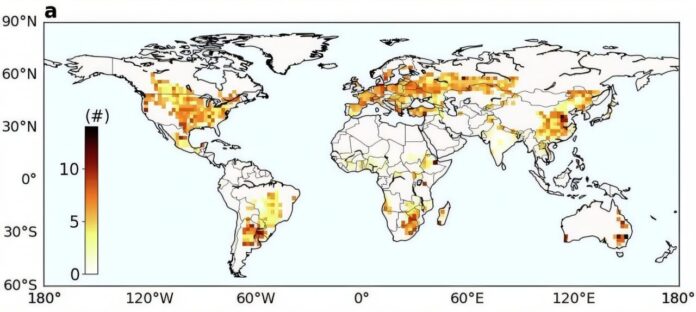A groundbreaking new study reveals a hidden factor driving global crop vulnerability: the source of rainfall itself. Published in Nature Sustainability, the research from the University of California San Diego challenges conventional drought predictions by emphasizing that where rain originates is just as crucial as how much falls.
Traditionally, drought risk has been largely assessed based on precipitation levels alone. However, this new study takes a deeper dive into the atmospheric water cycle, tracing rainfall back to its source – whether it evaporated from vast oceans or closer-to-home land surfaces like soil, lakes, and forests. This distinction, scientists say, significantly impacts a region’s susceptibility to drought and agricultural productivity.
The reason lies in the different ways rain originating from oceans versus land behaves. Ocean-sourced moisture travels long distances across continents, often carried by powerful weather systems like atmospheric rivers, monsoons, and tropical storms. These systems tend to deliver heavier rainfall events. In contrast, what’s known as “recycled rainfall”—moisture that evaporates locally from soil and vegetation—fuels more localized storms.
“Our work fundamentally changes how we view drought risk,” explains Yan Jiang, lead author of the study and a postdoctoral scholar at UC San Diego. “It’s not simply about total rainfall amounts; it’s about where that rain comes from.” Jiang emphasizes this new understanding empowers policymakers and farmers to predict and mitigate drought stress before it becomes an acute crisis.
Predicting Drought Risk with Satellite Data:
Using nearly two decades of satellite data, Jiang and co-author Jennifer Burney from Stanford University meticulously mapped the global distribution of rainfall originating from land sources. Their findings revealed a clear threshold: when more than about one-third of rainfall in a region originates from land evaporation, croplands become significantly more vulnerable to drought, soil moisture depletion, and diminished crop yields. This increased vulnerability stems from the inconsistency of land-sourced rainfall—smaller, less predictable showers that often fail to deliver sufficient water during critical growing stages for crops.
Two Global Hotspots Facing Unique Challenges:
The study highlights two regions of particular concern: the U.S. Midwest and tropical East Africa. Both areas exhibit high reliance on land-sourced moisture, making them especially susceptible to drought intensification.
-
U.S. Midwest: Once lauded as a model of agricultural productivity, the Midwest has witnessed increasing frequency and severity of droughts in recent years. This alarming trend, according to Jiang, is partly attributed to its heavy dependence on recycled rainfall. When soil dries out due to drought, it reduces evaporation, subsequently diminishing future rainfall – a self-reinforcing cycle that amplifies the problem. The consequences are far-reaching given the Midwest’s status as a major supplier of grain to global markets. Farmers in this region may need to prioritize strategies like improved soil moisture management, efficient irrigation practices, and strategically timed planting to counteract drought stress.
-
East Africa: This region faces a more precarious situation where the rapid expansion of cropland is directly threatening the very source of its rainfall—surrounding rainforests. “It’s a dangerous dilemma,” Jiang points out. “Farmers clear forests for agriculture, but those forests are essential to generating the rainfall their crops depend on.” If deforestation continues unchecked, local food security will be severely compromised.
However, Jiang remains optimistic. He emphasizes that East Africa is at a critical juncture where proactive measures can still avert disaster. By prioritizing sustainable land management practices—such as conserving existing forests and restoring degraded vegetation—it’s possible to protect vital rainfall sources and ensure long-term agricultural stability.
Forests: The Unsung Heroes of Rainfall:
This research underscores the crucial role forests play not just in biodiversity but also in sustaining agriculture. Forests act as natural “rainmakers” through extensive evaporation and transpiration (the release of water vapor by plants), effectively seeding clouds that deliver rainfall to nearby croplands. Protecting these ecosystems is vital to ensuring the continued productivity of agricultural lands.
A New Framework for Drought Resilience:
Jiang’s findings provide a groundbreaking framework for linking land management, rainfall patterns, and crop planning. This understanding has the potential to revolutionize drought resilience strategies worldwide. By using the study’s novel satellite-based mapping technique, governments and farmers can pinpoint areas requiring investment in irrigation infrastructure, soil water storage, and forest conservation—all key steps in securing a reliable source of rainfall for agriculture.
This research empowers us to move beyond simplistic views of drought risk and embrace a more nuanced, interconnected approach to safeguarding global food security.
































